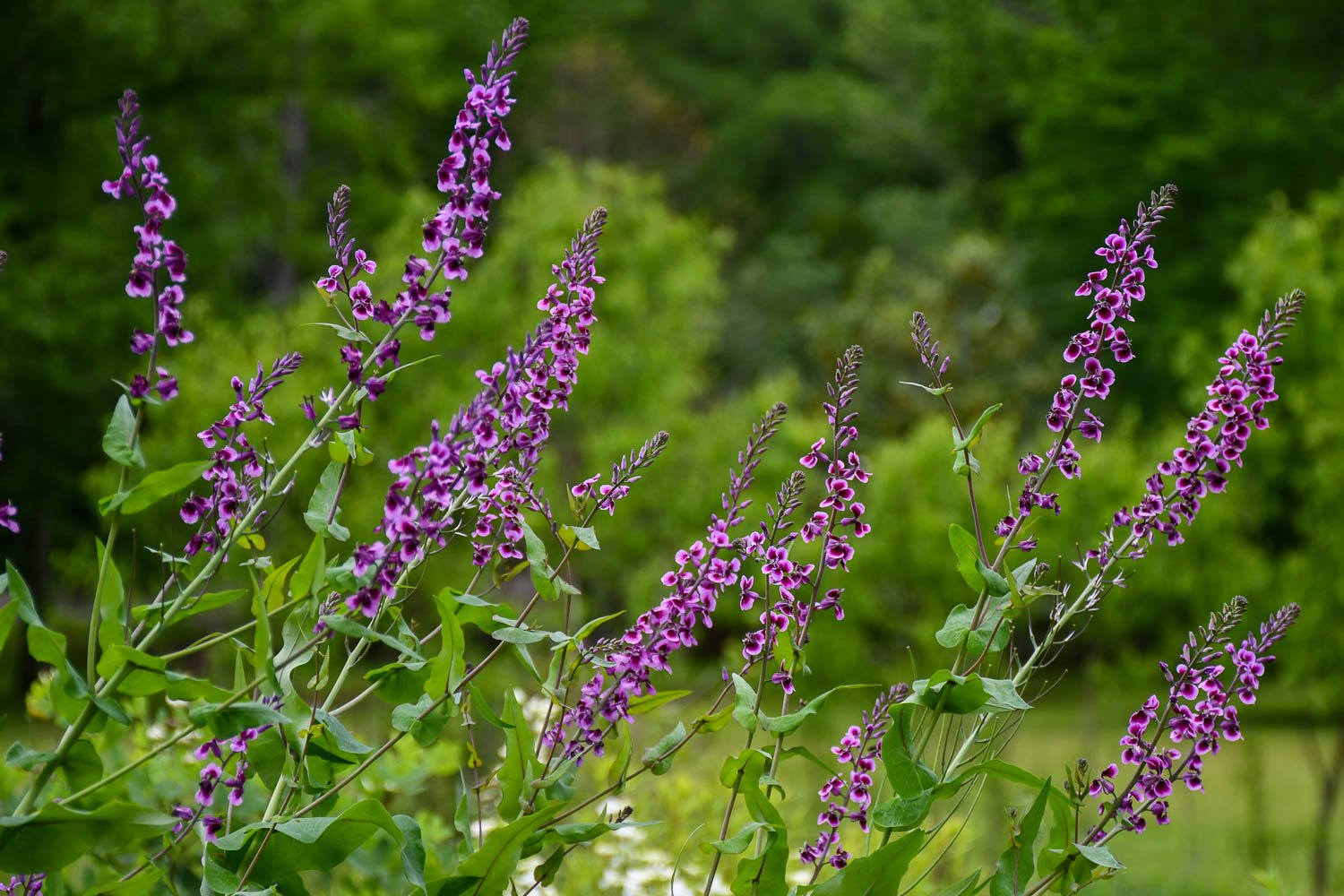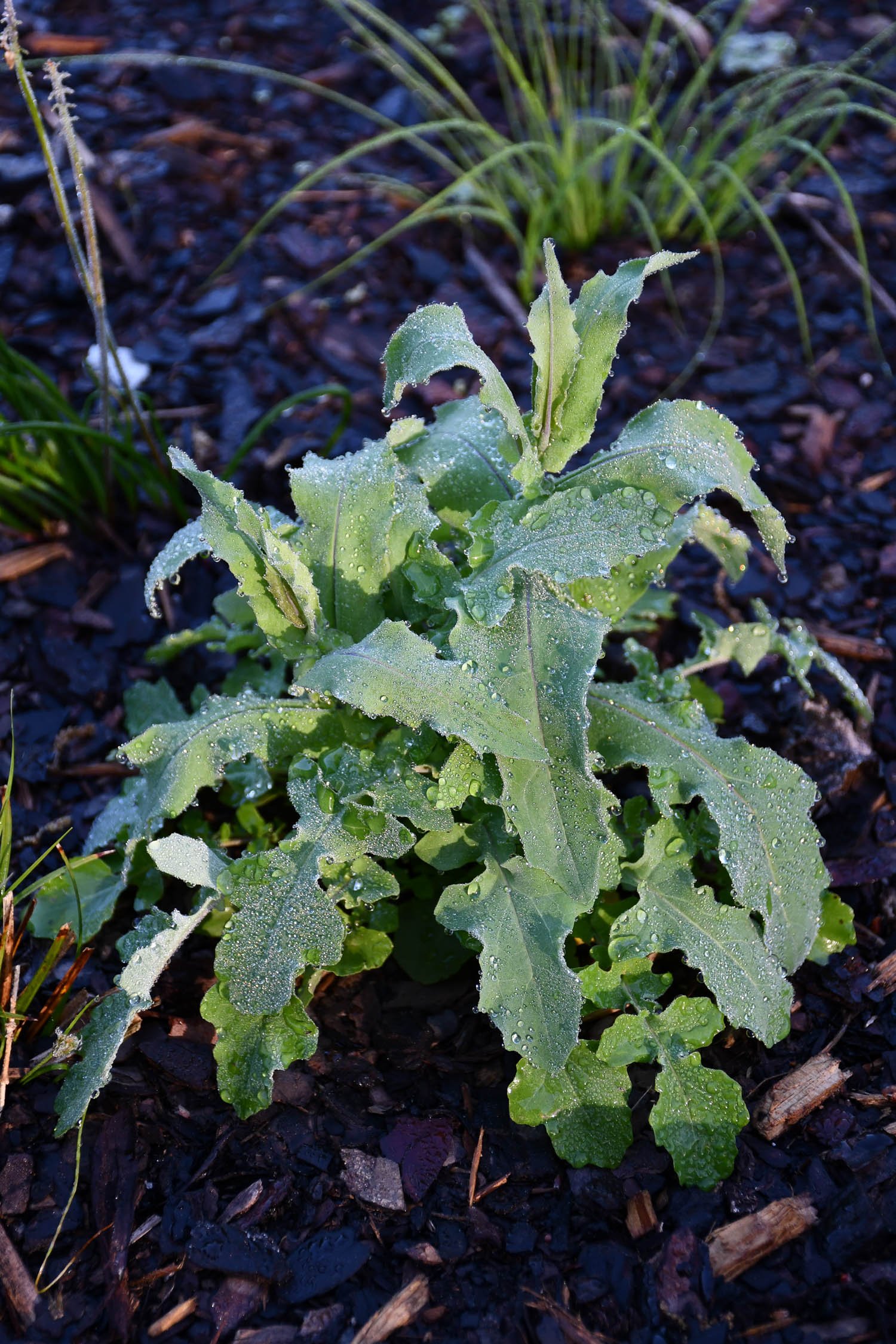Clasping jewelflower has sent me on a treasure hunt trying to figure out how to grow this beautiful native. After two failed attempts, I’m happy to report that I’ve had success this year with Streptanthus maculatus!
I first learned about this spectacular plant from naturalist Matt Buckingham. He posted on his website about it in 2019. That fall, by coincidence a friend of mine shared some seed with me they had collected further north in Texas.
I sowed them into trays that winter, planted the seedlings out that following spring, and was sorely disappointed to find them get barely above 6 inches tall. They were puny and sad looking. I was intrigued because the scale of the plants in the images that I saw from Matt’s blog looked bigger; however, maybe this height was as big as the plant grew, and he was just using a macro lens?
Last year, I decided to let mother nature take care of things, and I sowed the remaining seed on my front bank under dappled shade, thinking perhaps they weren’t too happy growing in peat or being transplanted. I was delighted when my plants grew and rose to a height of around 18 inches. But, they still looked spindly. My concerns that there was still something wrong were confirmed when my friend Mark Tietz posted some images of three-foot tall plants on Facebook and made me realize that this plant had the potential to get much taller and fuller. In his comments he shared that the plant grew on alkaline soils from ancient seabed sediment.
I had realized in my time at Ephemera Farm that I had better luck with plants if I sweetened the soil with lime prior to planting. Our pH of 4.2 has been rough on many native perennials, some even from just down the road that originally grew in less acidic soil.
Armed with this information, I collected what seed my plants produced on the front bank, and then set about sowing them this past winter. This time, I made sure to start them in slightly larger cells (32’s instead of 72’s). I planted 25 transplants. For most of them, I limed each hole prior to planting as if I was lightly dusting a beignet. The scientist in me made sure to not lime three holes to act as a control. The growth differences, as you can see below, were visible soon after planting.
March 25 2023: The control Streptanthus maculatus without lime added to the planting hole. Plants in the three plugs were stunted in growth.
March 25, 2023: A Streptanthus maculatus with a dusting of limestone added to the planting hole. Notice how much larger the leaves are compared to the control.
And, let me tell you, I am ecstatic to see how well the limed plants are doing this year. Most plants top out at two-to-three-feet tall, and they are loaded with flowers.
I cannot tell you how much joy I got from seeing these Streptanthus maculatus thrive after failed attempts.
And, if you’re wondering how the plants I didn’t lime fared, check out the images below.
A close up of one of the three Streptanthus maculatus plugs that didn’t receive lime. This plant is approximately 15 inches tall, and the other two look similarly bad.
And, a close up of one of a Streptanthus maculatus that did receive lime. This plant is three feet tall, and loaded with 50+ flowers in just one inflorescence!
To me, clasping jewelflower is a native Lunaria without the large translucent seedpods. The clasping name comes from the perfoliate leaves that wrap around the stem. I should note that the plants I have are Streptanthus maculatus var. maculatus with their more lance-shaped leaves. The other variety Streptanthus maculatus var. obtusifolius has more obtuse foliage.
My first Streptanthus maculatus coming into bloom earlier this spring. Don’t you know I was giddy! You can see in this image the opening flowers twist a bit, hence the other common name twistflower.
The two-tone flowers play so well off my already cool color scheme of pink and purple. Note the clasping or perfoliate leaves of clasping jewelflower.
Being in the Brassicaceae family, it has that classic four-petal cruciform flower shape. Another common name is clasping twistflower, which is a nod to the petals that twist a bit as they open. I’ve also had slight issues with cabbage looper worms trying to eat the leaves. A dusting of Bacillus thuringiensis brings them quickly under control. I was concerned about spring storms toppling them. They have bent a bit due to some storms (header image), but overall they are still mostly upright and standing. And, the honeybees LOVE them. Every afternoon they swarm the plants.
I was just fascinated to see how a little bit of lime transformed the growth of this native annual. I dug deeper into this plant’s propensity for alkalinity, and I found an interesting note about the closely related Streptanthus squamiformis (pineoak jewelflower), an Ouachita Mountain endemic. Virginia McDaniel reported in a 2014 edition of Claytonia, the newsletter of the Arkansas Native Plant Society, that they had seen similar scrawny plants in bloom when doing Streptanthus surveys. Then, her friend visited a site that same day that was burned earlier that year and discovered a purple haze of flowers. She stated, “As he climbed higher, the numbers increased and the plants got bigger. Hundreds of individuals were scattered across the mountain side!”
She hypothesized that the fire had created excellent conditions for germination. But, I’m wondering if there’s another effect from the fire. Ashes left from fires are known to raise soil pH and be a source of calcium (references from Michigan State and University of Wisconsin-Madison). I’m not sure if fire enhances germination for this species as it does others, but I’m left wondering could it be that the ash generated after a fire burns through helps create conditions ripe for these plants to have a sudden growth explosion if they are not already growing in a calcareous soil? I’m already mentally thinking of the next experiment to set up!
But, for now, I’m delighted to have found an obscure native with such horticulture potential. Clasping jewelflower has become a gem in the crown of my spring garden, and now that I know how to successfully grow it, I look forward to being bedazzled by its reappearance every spring.







